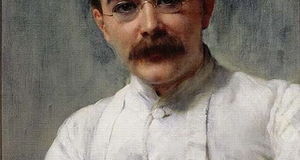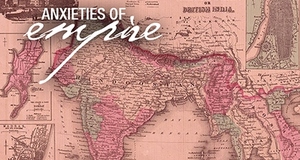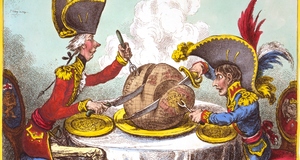Feminist and New Historicist Readings of Kipling's "The Man Who Would Be King"
By
2015, Vol. 7 No. 03 | pg. 3/3 | « ConclusionFeminist and new historicist readings of “The Man Who Would Be King” merge well with their analyses of the Anglo-Indian social taboo of miscegenation, and with their discussions of stereotypes of natives and native women. Both viewpoints analyze how Kipling’s British India is vital to varied readings of the story and allow for multiple interpretations because of the story’s inherent ambiguity. However, a new historicist reading of “The Man Who Would Be King” is more plausible because it focuses on historical and social backgrounds of nineteenth-century British India, of which Kipling was an intimate part as Britain’s “national” poet and spokesman of empire. A feminist reading of his story reads too much into authors’ homoerotic tendencies. Feminist criticism has produced similar homoerotic tendencies in the lives and works of such writers as Nathaniel Hawthorne, Gerard Manley Hopkins, James Joyce, D. H. Lawrence, and Herman Melville. Although E. M. Forster, Walt Whitman, Oscar Wilde, and others were homosexual, not every male writer was secretly so. Neither does misogyny in their work hide homosexual tendencies in their characters. Therefore, a feminist reading of the text is less plausible and palatable to heterosexual feminist critics (Guerin, et al 211-12).Critics are still reluctant to merge feminist, new historicist, and postcolonial readings of Kipling’s Indian fiction (McBratney pars. 17-21). Feminist critics see misogyny and subjection of both Anglo-Indian and native women, but not the subjection of women who are also natives. New historicist and postcolonial critics see natives as the “Other,” but fail to analyze native women as the “Other.” Still, feminist and new historicist readings of Kipling’s work are beginning to merge. Female critics of Indian origin have begun analyzing Anglo-Indian literature from feminist, new historicist, and postcolonial viewpoints.8 Even feminist critic Elaine Showalter quotes Edward Said, the father of postcolonial theories, in her revisionist work on the fin-de-siècle canon. She states that “sexual and racial images merged in the mythology of the dark continent and the Orient,” as made evident in Said’s Orientalism (“Apocalyptic” 71). Therefore, the future of a merging of feminist, new historicist, and postcolonial readings of “The Man Who Would Be King,” and likewise all of Kipling’s Indian fiction, appears bright. ReferencesBeckerman, Jim. “On Adapting ‘The Most Audacious Thing in Fiction.’” The English Novel and the Movies. Eds. Michael Klein and Gillian Parker. New York: Ungar, 1981. 180-86. Cornell, Louis L. Kipling in India. New York: St. Martin’s, 1966. Crook, Nora. Kipling’s Myths of Love and Death. New York: St. Martin’s, 1989. Fussell, Paul, Jr. “Irony, Freemasonry, and Humane Ethics in Kipling’s ‘The Man Who Would Be King.’” English Literary History 25.3 (1958): 216-33. Guerin, Wilfred L., et al. A Handbook of Critical Approaches to Literature. 4th ed. New York: Oxford UP, 1999. Gilbert, Sandra M., and Susan Gubar. The Madwoman in the Attic: The Woman Writer and the Nineteenth-Century Literary Imagination. 2nd ed. New Haven: Yale UP, 2000. Gilmour, David. The Long Recessional: The Imperial Life of Rudyard Kipling. New York: Farrar, Straus, & Giroux, 2002. Grella, George. “The Colonial Movie and ‘The Man Who Would Be King.’” Texas Studies in Literature and Language 22 (1980): 246-62. Kipling, Rudyard. “The Man Who Would Be King.” 1888. Maugham’s Choice of Kipling’s Best: Sixteen Stories Selected and With an Introductory Essay by W. Somerset Maugham. New York: Doubleday, 1953. 162-92. ---. The Works of Rudyard Kipling: One Volume Edition. NewYork: Collier, 1928. Mallett, Phillip. “Kipling and the Hoax.” Kipling Considered. Ed. Phillip Mallett. New York: St. Martin’s, 1989. 98‑114. Marx, Edward. “How We Lost Kafiristan.” Representations 67 (1999): 44‑67. McBratney, John. “Images of Indian Women in Rudyard Kipling: A Case of Doubling Discourse.” Inscriptions 3-4 (1988): 23 pars. Paffard, Mark. Kipling’s Indian Fiction. New York: St. Martin’s, 1989. Pinney, Thomas, ed. The Letters of Rudyard Kipling. 4vols. Iowa City: U of Iowa P, 1990. Roy, Parama. Indian Traffic: Identities in Question in Colonial and Postcolonial India. Berkeley: U of California P, 1998. Showalter, Elaine. “The Apocalyptic Fables of H. G. Wells.” Fin de Siecle/Fin du Globe: Fears and Fantasies of the Late Nineteenth Century. Ed. John Stokes. New York: St. Martin’s, 1992. 69-84. ---. Sexual Anarchy: Gender and Culture at the Fin de Siecle. New York: Penguin, 1990. Stewart, David H. “Kipling, Conrad, and the Dark Heart.” Conradiana: A Journal of Joseph Conrad Studies 19.3 (1987): 195-205. Sullivan, Zohreh T. Narratives of Empire: The Fictions of Rudyard Kipling. New York: Cambridge UP, 1993. Wurgaft, Lewis D. The Imperial Imagination: Magic and Myth in Kipling’s India. Middleton, CT: Wesleyan UP, 1983. Endnotes
Suggested Reading from Inquiries Journal
Inquiries Journal provides undergraduate and graduate students around the world a platform for the wide dissemination of academic work over a range of core disciplines. Representing the work of students from hundreds of institutions around the globe, Inquiries Journal's large database of academic articles is completely free. Learn more | Blog | Submit Latest in Literature |


















